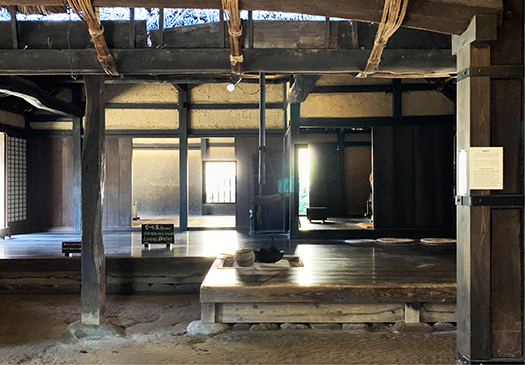


日本の住文化が世界の中で特異性を持つ部分で大きいのは床。
コロナ禍で注目された「床上げ」での靴脱ぎ習慣。
現代でも玄関は「土間」であり、この結界意識が清浄観念を担保している。
コロナウィルスは公衆的床面の除菌も有効ということから、
日本の靴脱ぎ習慣、土間の面積の小ささが衛生的な面から見直された。
欧米では家の中でも、ベッドに横たわるまでは靴を脱がない社会。
そう考えると、日本人の空間意識で床上げが志向されてきたことには
大いに意味があったということが言えるのでしょうか。
しかし一方で能動的室内空間としての土間面積が減少していったことは、
日本人の基底的な生活文化のある部分を捨象してきたとも思える。
土間から床に上がるとき、日本社会では足をきれいに拭く、洗う習慣がある。
そういう腰掛けに適度な「床高」が一般的に採用されてもきた。
その高さだと一段での踏み越えは容易ではないので、
置き石などがワンステップとして採用もされてきた。
足を洗ったりする作業にも、こういうステップは有効だった。
で、靴を脱ぐということから、床上げ空間では素足で床面と接してきた。
そういう経緯なので、板間もていねいにぞうきん掛け習慣が根付いてきた。
素足の感受力からはていねいな掃除が不可欠なのでしょうね。
それがまた、衛生思想を向上させていくことにも繋がっていく。
そういう素足での床面感受力の発達から、ラグジュアリーな床材として
日本独特な畳という素材が開発されて、広範に普及してきた。
畳という床建材は、まことに繊細な感受性を日本人に涵養した。
コメ文化圏の民族として、ストロー状の繊維質にリスペクトがあり、
その表面質感にはたぶん、日本人の精神性に刷り込まれているものがあると思う。
足の裏側で畳の応力の感じや、表面の滑らかさ、目の細かさが
いろいろに体験記憶として、重なり合ってきているのでしょう。
あるいは、畳の目を数えたりして、その幾何学的な美感も感受していただろう。
コトバとしては「畳の上で死ぬ」というような日本人的憧憬すら存在した。
こうした土間ー板間—座敷というバラエティのある床面が織りなす
意識水面下での「深層心理」が日本人の心理には深く沈殿していると思う。
土間の清潔についても、石灰が定期的に施されたり、
突き固めることでの平滑面の維持努力もあったのだろうと思う。
ただ、北海道では畳敷きの部屋が大きく減少傾向にある。
一時期の「ダニ」対策的な対症療法としての板間全盛になってきている。
また、全館暖房という側面からワンルーム志向が勢いづいて
個室としての「和室」が減少していく傾向にある。
そういう部分が今後どう推移するのか、興味深いと思っております。
English version⬇
[Doma / Itama / Zashiki Nippon Floor Culture / Good Japanese House ㉖-6]
The floor is the biggest part of the world where Japanese living culture is unique.
The habit of taking off shoes by “raising the floor”, which attracted attention due to the corona sickness.
Even in modern times, the entrance is “Doma”, and this sense of barrier guarantees the idea of cleanliness.
Since coronavirus is also effective in disinfecting public floors,
Japan’s habit of taking off shoes and the small area of the soil have been reviewed from a hygienic point of view.
In Europe and the United States, even in a house, a society where you do not take off your shoes until you lie down on the bed.
With that in mind, the fact that Japanese people have been oriented toward raising the floor with a sense of space
Can it be said that it made a lot of sense?
However, on the other hand, the decrease in the soil area as an active indoor space means that
It seems that some parts of the basic Japanese lifestyle have been abstracted.
In Japanese society, it is customary to wipe and wash your feet when you go up from the dirt floor to the floor.
An appropriate “floor height” has been generally adopted for such a stool.
At that height, it is not easy to step over one step, so
Placing stones have also been adopted as one step.
These steps were also effective for washing your feet.
So, because I took off my shoes, I came in contact with the floor with bare feet in the floor-raising space.
That’s why the habit of hanging elephants has taken root in Itama.
Careful cleaning is indispensable from the sensation of bare feet.
It will also lead to the improvement of hygiene ideas.
As a luxury flooring material from the development of floor sensitivity with such bare feet
A material called tatami, which is unique to Japan, has been developed and has become widespread.
The floor building material called tatami has cultivated a delicate sensitivity to the Japanese.
As an ethnic group in the rice culture, there is respect for straw-like fiber,
I think that the surface texture is probably imprinted on the spirituality of the Japanese people.
The feeling of stress on tatami mats on the soles of the feet, the smoothness of the surface, and the fineness of the eyes
It seems that they are overlapping as various experiences.
Or, by counting the eyes of the tatami mats, I would have been impressed with its geometrical beauty.
As Kotoba, there was even a Japanese admiration such as “dying on tatami mats”.
A variety of floors, such as dirt floors, board spaces, and tatami mats, weave together.
I think that “deep psychology” under the surface of consciousness is deeply precipitated in Japanese psychology.
As for the cleanliness of the soil, lime is applied regularly,
I think there was also an effort to maintain a smooth surface by tamping.
However, the number of tatami-matted rooms is decreasing significantly in Hokkaido.
Itama is becoming more and more popular as a symptomatic treatment for “tick” for a period of time.
In addition, one-room orientation is gaining momentum from the aspect of heating the entire building.
The number of “Japanese-style rooms” as private rooms tends to decrease.
I think it will be interesting to see how such a part will change in the future.
Posted on 3月 23rd, 2021 by 三木 奎吾
Filed under: 住宅マーケティング, 日本社会・文化研究







コメントを投稿
「※誹謗中傷や、悪意のある書き込み、営利目的などのコメントを防ぐために、投稿された全てのコメントは一時的に保留されますのでご了承ください。」
You must be logged in to post a comment.